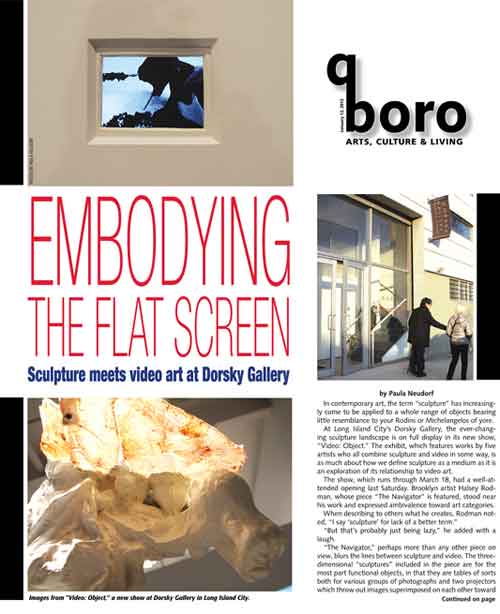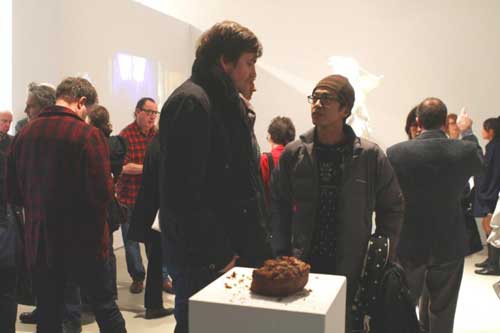
 Sculpture News at SculptSite.com
Sculpture News at SculptSite.com
Dorsky Gallery Objet Art Sculpture |
| QueensChronicle by Paula Neudorf, Associate Editor Halsey Rodman, Yasue Maetake, Moira Williams: Object Artista-SculptorsIn contemporary art, the term "sculpture" has increasingly come to be applied to a whole range of objects bearing little resemblance to your Rodins or Michelangelos of yore. At Long Island City's Dorsky Gallery, the ever-changing sculpture landscape is on full display in its new show, "Video: Object." The exhibit, which features works by five artists who all combine sculpture and video in some way, is as much about how we define sculpture as a medium as it is an exploration of its relationship to video art. The show, which runs through March 18, had a well-attended opening last Saturday. Brooklyn artist Halsey Rodman, whose piece "The Navigator" is featured, stood near his work and expressed ambivalence toward art categories. When describing to others what he creates, Rodman noted, "I say 'sculpture' for lack of a better term." "But that's probably just being lazy," he added with a laugh. "The Navigator," perhaps more than any other piece on view, blurs the lines between sculpture and video. The three-dimensional "sculptures" included in the piece are for the most part functional objects, in that they are tables of sorts both for various groups of photographs and two projectors which throw out images superimposed on each other toward a facing wall. The videos are documents of two events. First, in 2006, Rodman invited 12 artists to his Navy Yard studio to spend four hours sculpting Rodman's figure. A year later, he invited the same 12 artists to repeat the process. Each time, they stood in the same place around the same table where Rodman lay, sculpting body parts they were assigned by drawing lots. Both sculpting sessions produced two full sculptures of Rodman respectively, which he then paired in two separate pieces. "These sculptures are not on view at the gallery, because "The Navigator" is, according to Rodman, "about the structure of the way they were made." "The whole project is about trying to set up the conditions where vision turns into a process that has results," he said. "These objects sort of drop out of seeing something." As such, "The Navigator" is a kind of document or record, and the objects that facilitate the video projection become a seamless part of the video. Of the four other works on display, three draw a much harder line between object and video, to the extent that one piece can often overwhelm the other. Yasue Maetake's piece "If I were a Master Stone Carver," for example, includes a large, looming figure made of animal bone, hedgehog needles, crab shell and fur, according to an essay written by the show's curator, Laurence Hegarty. The piece has a magnetism that almost overwhelms Maetake's accompanying video projection, "Parthenogenesis," that appears on a wall near the sculpture. Maetake noted that she created the video piece and sculpture separately. In another work, "Exchange," by Moira Williams, the video piece draws your gaze, while the objects that accompany it - a coat that hangs from the ceiling, a piece of bread on a white pedastal and a microwave - seem less compelling. These objects document Williams' unusual project: she cultivates a plant called hairy vetch, known to remove toxins from soils, in her armpits. Once germinated, she removes the plants from her armpits and puts them into a "dirt shirt" which holds soil she has gathered from Superfund sites, mostly around Brooklyn, like a kangaroo's pouch. Williams then wears the shirt carrying the soil and the hairy vetch plants, watering the saplings using public spigots and fountains until they are fully grown. Now toxin-free, the soil and its hairy vetch plants are returned to the superfund site. Williams then cultivates beans from the plants, which she uses to make bread that she distributes to the community. "It's about the body and nature," Williams said of the piece. Williams' video on display at the Dorsky features the artist staring into the camera's lens as if it were a mirror, with her arms raised, revealing the hairy vetch seeds. At first glance, it's difficult to tell what the seeds are. Noah Dorsky, one of the gallery's owners, explained that because the gallery is a nonprofit - it solicits curators, rather than artists, to present shows in the space, and is not directly involved in the sale of any pieces on display - the gallery is free to show controversial or experimental work, regardless of any commercial regards. |
 Here we go again - time and sculpture... Thousands of years have passed and the digital age is upon us - sculpture moving to the screen and speakers, not to mention the human body all time-lapsed... This is important, yes, maybe more important to some, less to others, but still important! Maybe this is where the new frontiers are located - maybe not? Still quite interesting and a great big thanks to all involved in this exhibition, which by the way might be a very enlightening experience! Click here for a PDF of the exhibition, enjoy! 'Video: Object'
When: Through March 18. Thurs.-Mon. 11 a.m.-6 p.m. |
 PHOTO BY PAULA NEUDORF |
 The opening reception for "Video: Object" at Dorsky Gallery in Long Island City on Sunday, Jan. 8. PHOTO BY PAULA NEUDORF |
More Sculpture News ....
Submit your SCULPTURE NEWS.
It's easy, just send us an e-mail
(click on Submit News in the left menu) with your pertinent information along with images, we'll take care of the rest. Sculpture makes our world a much better place in so many ways!
SculptSite.com, along with Sculptors and their creative genius all helping to bring the beauty and message of Sculpture to a hurried world.

